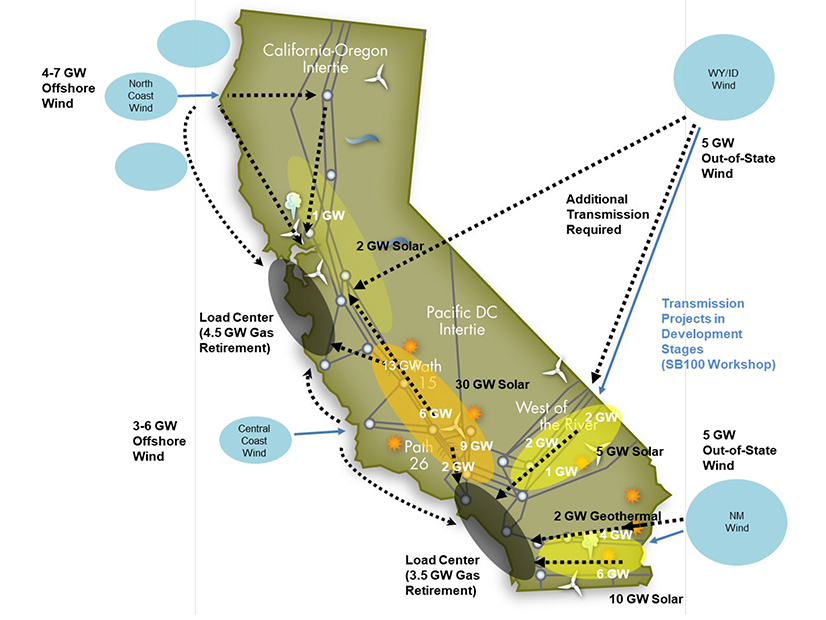
SACRAMENTO, Calif. — Two bills introduced in the California legislature this year are intended to speed up approval and construction of transmission projects necessary for the state to meet its goal of supplying 100% clean energy to retail customers by 2045 while maintaining grid reliability.
One measure, Senate Bill 420 by Sen. Josh Becker, would require the governor to identify a lead agency to “monitor clean energy and electrical transmission facility planning and deployment” needed to achieve the targets of Senate Bill 100, which established the 100% clean energy mandate in 2018, and last year’s SB 1020, which set interim goals of using 90% carbon-free electricity by 2035 and 95% by 2040.
A project that the agency identifies as necessary to meet the goals would qualify for streamlined government approval and faster court review of lawsuits filed against it. It could also receive expedited review by the California Public Utilities Commission if CAISO’s Board of Governors determines it is the most cost-effective solution to a “specific transmission expansion need” identified by the CPUC in its resource planning role.
Lawsuits and “duplicative review” by CAISO and the CPUC can delay transmission projects for years, Becker said in a news release.
“This isn’t about cutting corners,” the state senator said. “It’s about streamlining the process and getting power where it needs to go in a reasonable timeframe. We talk a lot about bringing new clean energy projects online, and while that is critical, it’s only one piece of the puzzle. We need to be able to get that power from the plant to the homes and businesses that need it.”
The bill will be heard in the Senate Environmental Quality Committee on March 29.
CEC Certification
Another measure, SB 619 by Sen. Steve Padilla, would expand the California Energy Commission’s power to certify transmission projects entailing a capital investment of at least $250 million over five years.
Legislation signed by Gov. Gavin Newsom in June allowed the CEC to consolidate permitting for generation, storage and transmission lines that carry clean power to junction points with existing transmission. The CEC approval generally bypasses other federal, state and local permitting processes. (See California to Pass Sweeping Energy Policy Changes.)
Padilla’s bill would remove the requirement that power lines connect with existing transmission and allow the CEC to approve projects “regardless of whether the electricity is carried to a point of junction with any interconnected electrical transmission system,” the state Legislative Counsel’s office said in its summary of the measure.
The bill is short and vague on details. It is “intended to be the starting point for a much larger and overdue conversation within the Legislature on how to meet our climate goals, deliver reliable power to homes and businesses, manage costs, and add transparency to modernizing California’s electrical grid,” Padilla’s office said in a statement.
Padilla and Becker both cited CAISO’s inaugural 20-Year Transmission Outlook, released in February 2022, as support for their bills. To meet SB 100’s goals, the ISO projected the state needs $30.5 billion in new high-voltage lines to transport renewable power from remote areas to urban load pockets. (See CAISO Sees $30B Need for Tx Development.)
The amount includes an estimated $12 billion for 500-kV AC and HVDC lines to carry 10 GW of out-of-state wind power from the Great Plains and Rocky Mountain states; $11 billion to upgrade CAISO’s system with 230- and 500-kV lines to transport solar and geothermal power; and $8 billion for 500-kV and HVDC lines to carry 7 to 13 GW of California offshore wind to major urban areas.
“Meeting this unprecedented demand will require California to simultaneously accelerate planning, siting, permitting and construction of a modern electrical grid, while carefully managing its costs,” the statement by Padilla’s office said. “Current transmission projects are delayed by almost five years and have run up tens of millions of dollars in extra costs.
“Absent substantial changes to the state’s current planning and permitting processes, California will not meet its visionary climate goals, and the state’s fragile energy grid will experience unprecedented strain,” it said.
